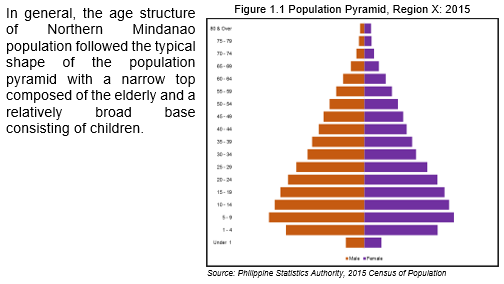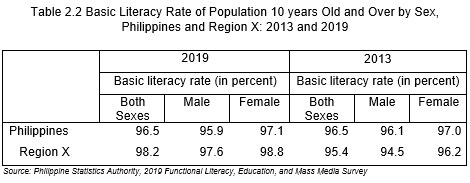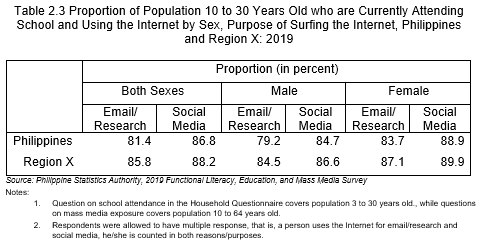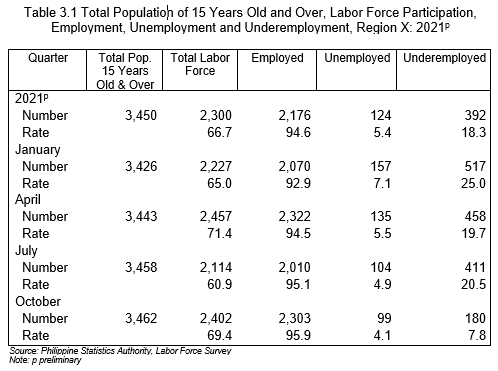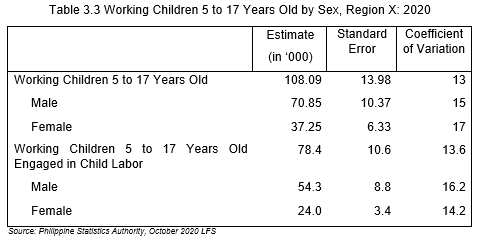POPULATION
The total population of Northern Mindanao as of 01 May 2020 reached 5,022,768 based on the results of the 2020 Census of Population and Housing (2020 CPH). This had ranked Northern Mindanao in the top 9 of the most populous regions in the country. The population as of 2020 is higher by 333,466 compared to the population of 4.69 million in 2015.
Comparison of Men and Women Population
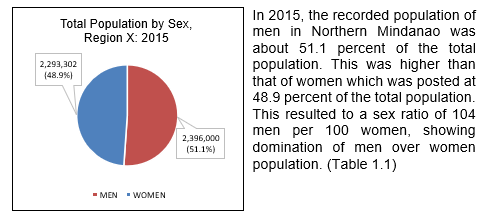
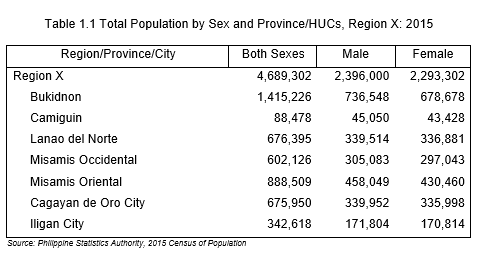
The province of Bukidnon recorded the highest population count for both men and women among all the provinces and highly-urbanized cities (HUCs) in the region. Its total population of 1,415,226 comprised of about 52 percent men and about 48 percent women.
Age Structure
Voting Population
Youth Population

Population of Senior Citizens
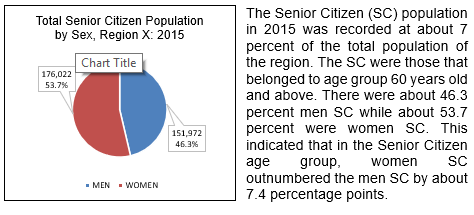
Population based on Marital Status
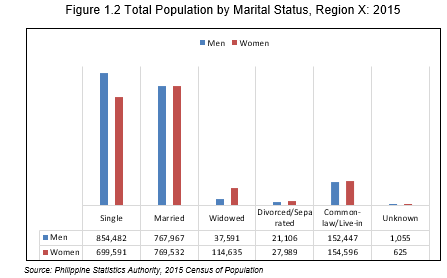
EDUCATION
Basic Literacy
In 2019, the basic literacy rate of population 5 years old and over for Northern Mindanao was at 95.2 percent, which was higher than the average literacy rate of the country posted at 93.8 percent. This made the region ranked fifth among the other regions bearing a high literacy rate.
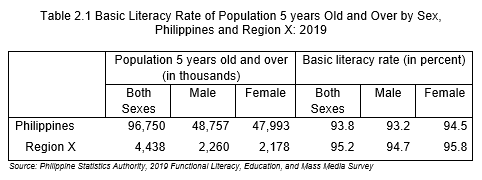
The women basic literacy rate of population 5 years old and over in the region was about 95.8 percent, which was higher than that of men at 94.7 percent.
On the other hand, Northern Mindanao’s basic literacy rate of population 10 years old and over increased year-on-year from 95.4 percent in 2013 to 98.2 percent in 2019. Basic literacy rates for women were higher than that of men for these two periods.
In terms of internet usage, women in the region who were between 10 to 30 years old and were currently attending school were more inclined to use the internet for email/research or social media than their male counterpart.
Functional Literacy
The functional literacy rate of the region's population 10 years old and over in 2019 was 95.4 percent. Women (96.8%) had a higher functional literacy rate than men (94.0%). Compared to the 2013 functional literacy rate, the region showed a higher functional literacy rate in 2019.
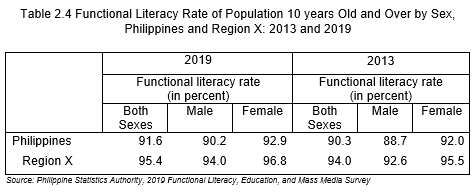
WORK AND ECONOMIC PARTICIPATION
In 2021, the Labor Force Participation Rate in the region was recorded at an average of 66.7 percent of the total population 15 years old and over. In the same year, the employment rate was posted at 94.6 percent while the unemployment rate registered at 5.4 percent. On the other hand, underemployment rate was reported at 18.3 percent. (Table 3.1)
Population of Overseas Filipino Workers (OFWs)
The population of Overseas Filipino Workers (OFWs) from the region fell to about 59,000 in 2019. This group was composed of 42.4 percent men and 57.6 percent women. The OFWs from Northern Mindanao accounted for about 2.7 percent of the total population of OFWs from the country. Women OFWs outnumbered men OFWs in 2018 and 2019.
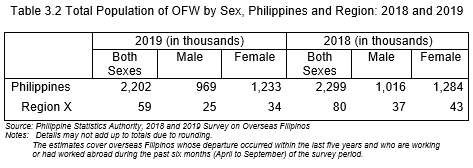
Working Children
In 2020, the number of working children 5-17 years old in Region X was at 108.09 thousand. This is comprised of about 65.5 percent boys (70.85 thousands) and 34.5 percent girls (37.25 thousand). On the other hand, the number of working children 5-17 years old engaged in child labor was estimated at 78.4 thousand. Seven out of ten children engaged in child labor were boys (54.3 thousand) while three out of ten were girls (24.0 thousand).
VITAL STATISTICS
Live Births
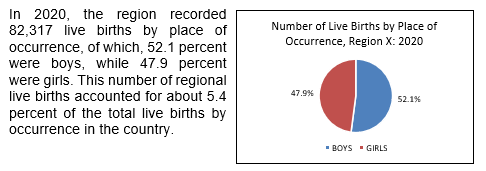
Meanwhile, on the same year, the number of live births by usual residence registered at 81,001. This was about 11.1 percent of the total live births by usual residence in the country. (Table 4.1)
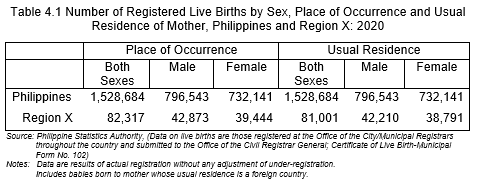
Marriages
In 2020, there were a total of 13,655 registered marriages in the region. It was on the month of February 2020 that the highest number of registered marriages took place. A total of 2,363 marriages were registered on the said month. The lowest number of registered marriages took place on April 2020 with only 67 marriages.

Bukidnon had the highest number of registered marriages in 2020 with 5,375 marriages. This accounted for about 39.4 percent of the total registered marriages in the region. On the other hand, Camiguin with 245 registered marriages recorded the lowest.
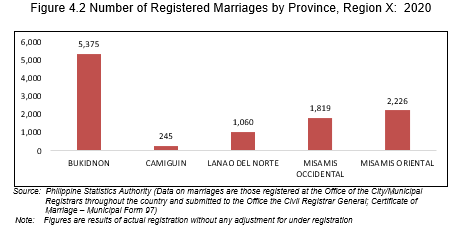
Deaths
Northern Mindanao registered a total of 26,576 deaths in 2020. Of this, 15,407 or about 58 percent were men, and 11,169 or about 42 percent were women. (Table 4.2)
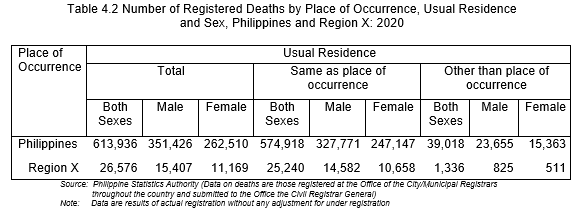
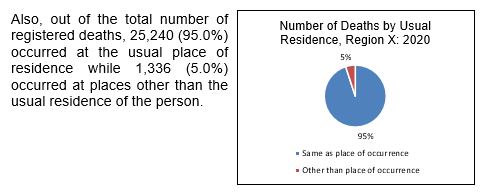
Around 57.8 percent men and 42.2 percent women died in the same place as their usual residence while 61.8 percent men and 48.2 percent women died in places other than their usual residence.
(Sgd.)JANITH C. AVES, CE, DM
(Chief Statistical Specialist)
Officer-in-Charge
For further inquiries, you may contact:
Statistical Operations and Coordination Division
Philippine Statistics Authority – Regional Statistical Services Office X
3F, Limketkai Module-2 BPO & Cyberpark Building,
Rosario Crescent, Limketkai Center, Brgy. 31, Cagayan de Oro City


